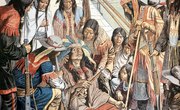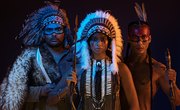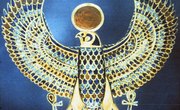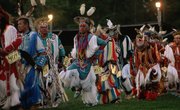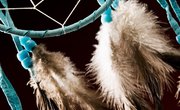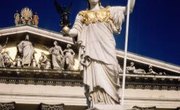The Algonquin people are Native Americans who speak the Algonquin language and trace their origins to Canada, specifically the Ottawa River of Quebec and Ontario. Algonquin Indians also settled in Nova Scotia, as well as the states of Maine, Vermont and New York, close to the Canadian border. Historical evidence of their settlements dates back to the Archaic period of 4280 B.C. and possibly earlier. Their first known meeting with Europeans occurred in 1603, when they encountered French explorers. Today, most Algonquin Indians live in Quebec, where nine of the ten separate nations are based.
Kitchi Manitou
Like many other Native American tribes, the Algonquin Indians were deeply spiritual and had a religion founded on animism, the belief that a spiritual world animated and interacted with the physical world. Instead of a divine being or god, the Algonquins believed in an essential spirit or all-encompassing force called Kitchi Manitou. Sometimes spelled Gitche Manitou and also known as the Great Spirit, Kitchi Manitou created and inhabited the entire universe, according to Algonquin folklore. Kitchi Manitou was believed to be present not only in living things such as people and animals, but also bodies of water, the sun and the moon.
Wendigo
The Algonquin Indians also believed in a demonic spirit called the Wendigo. In Algonquin legend, people who got lost in the woods would resort to cannibalism and thus become Wendigos. These starved individuals returned home from the forest as changed people, now violent and anti-social. Inhabited by the evil spirit, they had an overpowering need to consume human flesh. The only way to destroy the Wendigo was to kill the possessed person and burn his or her corpse to ashes. Variations of the legend describe other ways for people to become Wendigos, including being bitten by a possessed entity or cursed by a shaman.
Shamans
In Algonquin culture, shamans or medicine men served as spiritual intermediaries. A shaman was the only person capable of communicating with spirits and influencing their power over the physical world. Because of their knowledge and abilities, shamans were considered the most important spiritual leaders in the tribe. Spiritual practices of an Algonquin shaman included carrying out rituals to cure the sick. To treat someone afflicted with an illness, the shaman performed magical rites to drive out evil spirits from the body. Conversely, a shaman could put a curse on someone to bring on sickness. Shamans also had dreams and visions, which held great significance to the Algonquins. For example, if a shaman had a vision about herds of caribou in a particular location, the hunters went there to stalk their prey.
Ceremonies
Ceremonies and feasts were a vital part of Algonquin culture. Algonquin Indians celebrated special occasions throughout the course of the year. They rejoiced in the changing of the seasons with ceremonies that reflected their respect for nature. They also performed sacred rituals to commemorate the life phases of birth, puberty, marriage and death. During these ceremonies, the Algonquins often painted their faces to express emotions. The color red symbolized life, black meant death or eternal grief, and purple signified royalty or marked a momentous life event. Algonquins sometimes wore masks in ceremonies that were intended to cure illnesses or ward off evil spirits. Sacred beads called wampum, made from small shells, also played an important role in rituals; wampum were used in ceremonial jewelry, belts and sashes.
Related Articles
References
Writer Bio
Shannon Leigh O'Neil, a New York City-based arts and culture writer, has been writing professionally since 2008. Her articles have appeared in "GO Magazine," "The New York Blade" and "HX Magazine," as well as online media. O'Neil holds a Master of Arts in modern art history from the City College of New York, where she also studied French and minored in classical languages.





